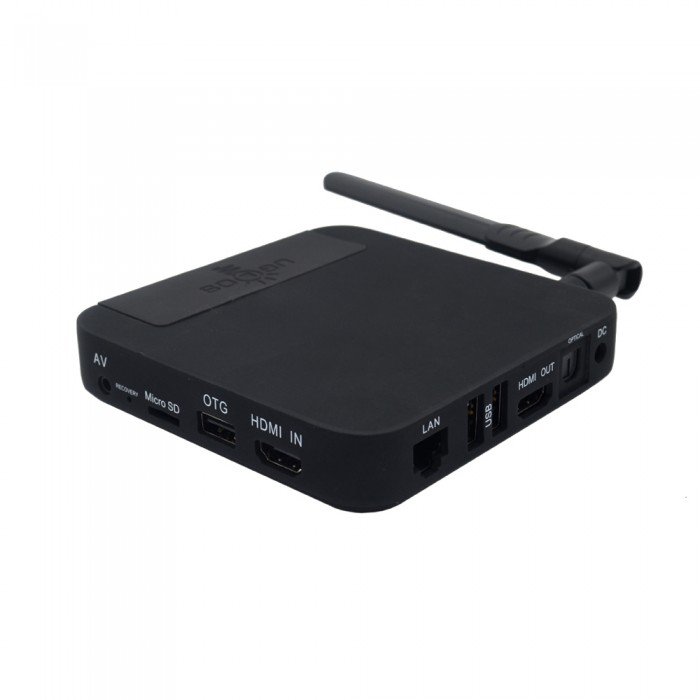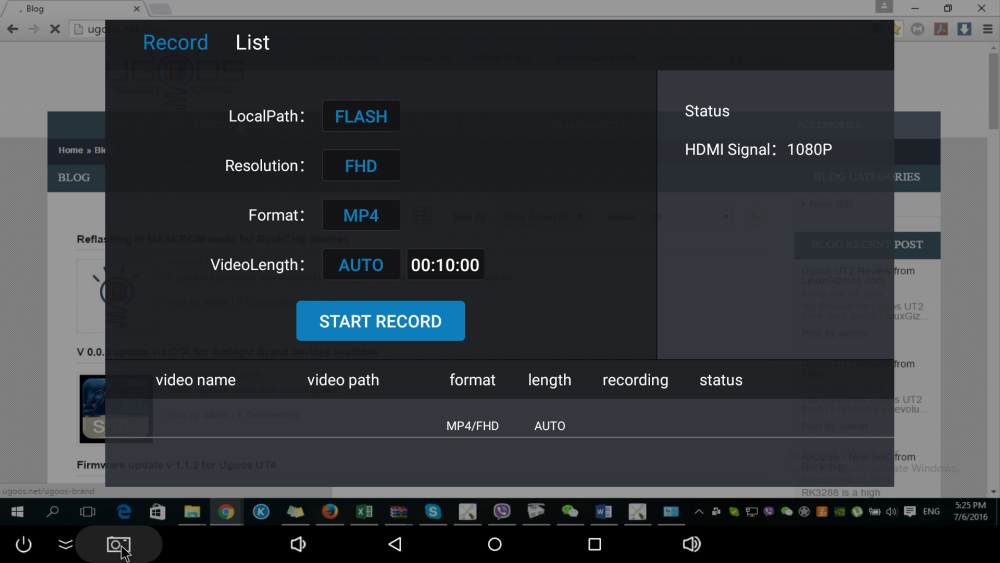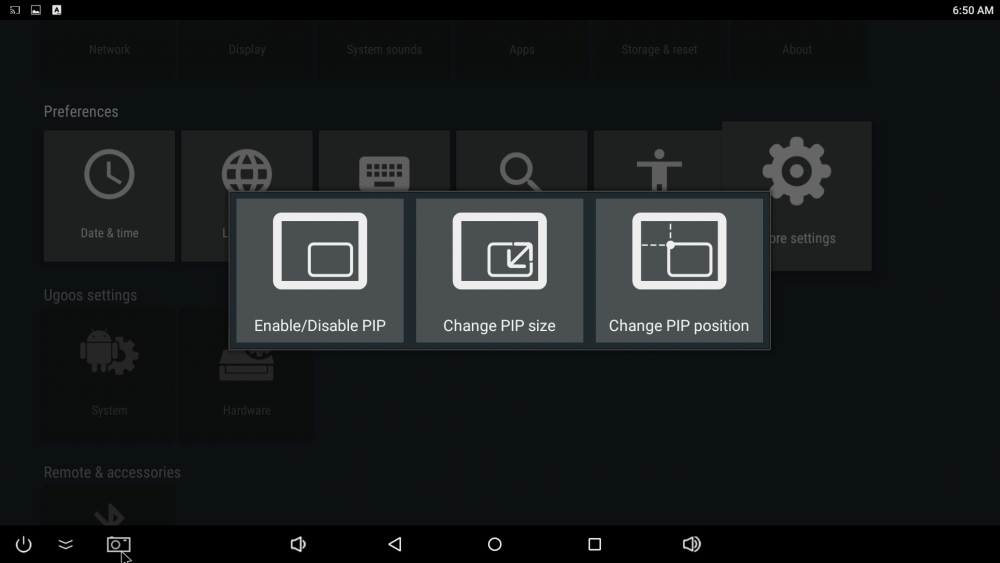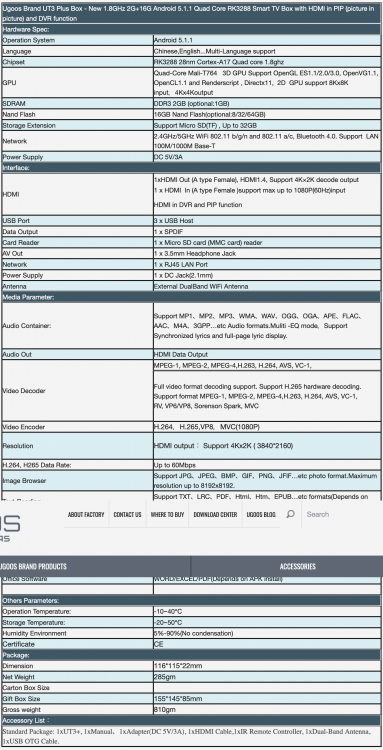
e97
-
Posts
27 -
Joined
-
Last visited
Content Type
Forums
Store
Crowdfunding
Applications
Events
Raffles
Community Map
Posts posted by e97
-
-
Collabora released Wayland running on RK3399: https://www.collabora.com/news-and-blog/blog/2020/06/05/bifrost-meets-gnome-onward-upward-zero-graphics-blobs/
-
Working on Wayland integration and would like a good starting point.
Please post which boards work and specific test results.
I'll keep the list updated.
Board Overall GPU
accelerated
Desktop
WebGL VPU encode VPU decode
4K@60
10-bit
HEVC
OpenGL ES 3.2 OpenCL 1.2 NanoPi TC4 ? OK NanoPi M4 ? Some freezing RockPro 64 OK OK
X11
OK
Chromium
? OK OK OK Khadas EDGE ? OK RockPi 4B Install failed ? ROCK960C ? OK last updated: 2020-06-01
-
My company was able to get the datasheets.. Hope to open source the driver and image as soon as possible
-
Been using Atomic Pi (x86) with OpenWRT for a while now
AtomicPi 4x 1.44 (1.92) Ghz 2GB 1X LAN - = $30
Not dual native but..
Nanopi R2S is essential the same with integrated RTL8153 (USB 3.0 to Gig-E) $22
NanoPi R2s 4x 1.4 Ghz 1GB 1x WAN, 1X LAN - = $22
Since the AtomicPi has double the RAM and AES-NI - would stick with that but has slightly higher power usage and its x86 vs arm.
-
Is V4L2 for rk3288 encoder mainline or is there a patch set?
-
Did some more digging and even though its an "old" product, its still produced for OEM customers using it for current products.
The HDMI-IN is via a HDMI-to-CSI chip, Toshiba TC358749
HDMI IN -> MIPI CSI -> RK3288
This explains why its implemented as a webcam in android. The CSI variant already has a linux driver in mainline : https://github.com/torvalds/linux/blob/master/drivers/media/i2c/tc358743.c
-
On 11/19/2019 at 4:54 PM, gounthar said:
You make it sound as if it was easy.

It looks really difficult to me, but that's super cool to know that it worked for you.
Thanks for the link.
everything's easy.. AFTER you've done it

-
ffmpeg with hw encoding 1080p/60 (some stutter) working on stock debian image
don't have my board at the moment. process was:
1) get orange pi linux sdk and debian image
2) pull armbian latest
3) diff debian config, cherry pick HDMI, audo, encoders
4) diff kernel, cherry pick hdmi, audio, encoders
5) compile and flash
if you don't want to tinker and 1080p30 is sufficient @ H.264: https://www.inforcecomputing.com/products/application-ready-platforms/qualcomm-snapdragon-600-inforce-6420t is $99 and you get helpful support
-
Found an old (2015) Ugoos UT3+ / UT3 Plus with an rk3288 - the neat thing about this board is it has HDMI-IN !

Also has PIP
Specs:
I'm was eventually able to successfully screen capture @ 1920 x 1080 ~29 fps using the Android 5.1.1 firmware V3.0.7 for UT3+ https://mega.nz/#!cQpl0ICS!8EgHddI3_PXQsSe-TSrkHfxdHCmkbckNWBYuLhfuA7w
The firmware crashes frequently and the painful part is the IR remote is required to start recording.. so I'll be porting gentoo / armbian to this device to turn this paper weight into a linux friendly screen capture device.
It maybe also worthwhile to document the process and create an armbian porting guide.
Aside, for those interested, its worth to mention the LKV373A HDMI / ethernet sender is a potential $30 HDMI screen capture alternate.
-
Anyone seen any Wayland demos / guides for ARM SBCs ?
-
Yes, I've used older RK3288 STB with HDMI-IN. In the end, went with a server motherboard with IPMI.
It may be possible to use the serial console and an arduino or pi
-
Add Raspberry Pi 4 with USB 3.0 adapter!
RTL8153 works OOB on linux
On 6/7/2019 at 5:57 PM, olivluca said:No, I mean the SBC you used in your "success" message above, where you say you got 850Mbps throughput (with or without NAT btw?).
Modem <-> SBC <-> Switch <-> Devices.
900+ with NAT on multiple SBCs.
-
Haven't decided on a final config becuase theres more testing to be done.
Easiest would be Atomic Pi (x86), your fav minimal distro and a USB 3.0 to Gigabit Adapter, about $50 shipped in the US (not including power supply)
Cant recommend any MIPS / ARM boards because it requires backporting netflow to your kernel and/or SIMD optimization. If you can do that, you can find the boards from the specs listed above and take into account the state of firmware/software to make an informed purchase.
-
Success!
Using a minimal distro and an SBC with min specs:
+ dual core @ 1.8 Ghz
+ DDR4
I was able to get 850+ Mbps firewall with QoS!
Tested multiple methods:
- integrated NIC + USB 3.0 Gigabit adapter
- integrated NIC + PCI-e NIC
- dual PCI-e NICs.
For under $50 and under 15W
Used this guide https://blog.tjll.net/building-my-perfect-router/ as a starting point. Used unbound for local dns reslover and a few other changes to traffic shaping and metrics; using prometheus and grafana
There's still room for improvement, get power under 10W and maybe closer to 5W-8W.
Lower cost if there was a board with integrated dual gigabit NICs !!
-
On 11/4/2018 at 4:41 PM, chwe said:
if you don't do it on your own, a TV box will likely never get 'official' armbian support.. maybe @balbes150 supports it. Even the Khadas Vim isn't supported and it's more likely a SBC..
Messing around with TV boxes is always a mess. They change things (e.g. change wifi chips, ram etc.), there are no schematics available and nobody has capacity to deal with such stuff. Better go for the cheapest RK3399 based TV box and buy the same USB GbE dongle.. Where you have proper mainline support and for multimedia use-cases chances are high that this stuff can be enabled with the BSP kernel.
I'm well aware. To be clear, I DO NOT expect ANYTHING from the community. If someone shares an interest and shares info/knowledge/code GREAT, happy to work together

Just documenting my thought process here as it may be helpful to others and shed some insight into SBCs. Its important that we improve the visibility of products and manufacturers that listen to feedback, continually improve their products and work with the community, not expect any support to be handled by the community.
HINT: If a board manufacturer lists forum/community under support - run! Run as fast as you can, as far away from them as you can.
-
2018-11-4 update
Looks like Amlogic S905x2 SoC boxes are being released.
quad Core A53 + 4GB + 32GB ROM + gigabit + usb3.0 ~ $57 + $10 USB 3.0 gigabit RTL8153 adapter = $67
Amlogic has decent BSP support and arguably better color reproduction, good for TV boxes, not relevant for network appliances
Almost there, with armbian or arch support and $17 discount this COULD work.. don't get your hopes up
-
Summary of potential boards:
NXP FRDM-LS1012A 1x 800 Mhz 512MB 2x NIC - = $50
GlobalScale ESPRESSObin 2x 1.3Ghz 1 GB 1x WAN, 2x LAN - = $49
Linksys WRT1200AC (refurb) 2x 1.2 Ghz 512MB 1x WAN, 5X LAN 2x2 802.11ac = $40
-
15 hours ago, chwe said:
shouldn't vlan exactly solve such issues/concerns? I think it needs a vlan capable switch as well.. No idea, never spent much attention to VLANs.
there have been VLAN CVE, rather encounter a security issue down the road - eliminate the problem with separate NICs. simple is always best
Quotedo those MT7621 boards get regular kernel updates? Otherwise this would IMO be a bigger security issue. I've no experience in MIPS world.. Only an old ASUS router and it was just the wrong device..

Isn't it a kickstarter board?

Mainline kernel has support. You may lose some HW features but patching is not too hard, fortunately I only need firewall and QoS so that shouldnt be an issue. yup it was the the last board I ever helped kickstart. Now I wait to see if a board survives to mass production - like the Pi. I did back Parallella and was pleasantly surprised but that speaks to the caliber of the people working on the project. The founder is now a DARPA AI/compute project lead. I am pretty excited about the Ryzen V1000 boards coming out.
Quoteor the company goes bankrupt and a new one tries it.. Or the cut support for a board which doesn't sell well..

if you look at the "companies" releasing the boards, you'll see its the same people under a different "brand" name.
QuoteTry and error? until you find a board which sells good. Or it's not needed to make profit in the first years/months.
If you have lots of money to burn and want to encourage more bad boards, sure buy them all. I'll wait and see what survives. The smaller companies have to make a profit to survive unless they have tons of investment or are part of a much larger company. I mean look at Asus Tinkerboard, it still has issues and it used a few year old SoC and was made by a Tier 1 x86 motherboard manufacturer.
QuoteI think the R1 had issues with the switch (never owned one, you may ask other or use the search engine)? R2, never saw someone who reached GbE speed with mainline.. at least I didn't. W2 no idea, it sits there since a few weeks but I didn't have enough time to dive into the adventure (there are still a bunch of open questions for the board/SoC - mainline is more or less non existing, let's give it some time to see where it ends).

Yes, have given up on any type of router boards - looking at the block diagrams and datasheets will reveal numerous issues..
Quoteyou've a x86 2GbE server vor <50$? or just reuse an old one? Power-consumption for a 24/7 system should also be considered. Thought about a ARMADA A388 based one? e.g. ClearFog Base?
Old x86 server I have around, it E3 Xeon uses ~25W since its server hardware. You can get older Xeons on ebay for very cheap.. But thats still 5x more vs a typically router ~5W. I forgot I also got a Linksys AC1200 refurb for $USD 40 which has an A385
 . Was testing LEDE and ZFS on it. Will be putting debian on it now and will likely meet my needs.
Quote
. Was testing LEDE and ZFS on it. Will be putting debian on it now and will likely meet my needs.
QuoteFunnily complaining about software/hardware support but then setting a price-tag which is IMO a way to low.. Support is only for free when people waste their spare-time..
 Otherwise it's part of a support contract or gets added at initial board-price.
Otherwise it's part of a support contract or gets added at initial board-price.
Yes, that's why industrial boards are expensive in addition to better spec-ed components. But I'm not looking for an industrial board - just one that has proper hardware at least, the software I can be fix. However, the NXP board I mentioned has an EXCELLENT BSP and hardware and support and its $50.. perhaps its subsidized as NXP to sell more chips since NXP is usually pretty expensive SoC-wise. I'd like to see any other manufacturer come out with something of comparable quality.
2 hours ago, sfx2000 said:Just sharing...
Old project - looked at Armada 3720 and TI's Sitara (AM3352) - both had fairly flexible interfaces for Gigabit Ethernet... Sitara was interesting as the MAC's could be implemented as switched interfaces.... Armada had faster/better interfaces... so the choice was simple....
Project did two runs of HW - first 20 P0 boards were "stretch" boards, second run (P1) was in the Pi format - mostly to reduce overall costs - think Pi board without HDMI/GPIO, microUSB as console, power on barrel connector where Pi's do audio in/out - swap the USB/Network connectors for 2 USB and 2 1GBit connectors, and you get the picture... With no WiFi, we were able to crowd everything on to a single sided board to reduce manf costs - including 2GB RAM and an 8GB eMMC - it was a clever design - and I'm still happy to have done it.
What killed the project wasn't the Bill of Material - it was all the ancillary costs, because of agreements/constraints - basically everything else besides the board itself - building/running a business as a HW startup... We couldn't do manf in Shenzen, we had to do in US (contractual restraints), and then all the logistics... Regulatory - FCC Part 15B can be a killer in and of itself - to be legit, you gotta pass that one, and it's $80K just for that testing per run - 15B is unintentional RF radiators... luck was that the P1 boards did pass...
Thank you for sharing. Most people don't know the difficult to bring a physical product, much less consumer electronics to market. Fortunately, one of my advisors helps manage supply chain for a certain fruit company. Their advice and experience was invaluable.
After being burdened by one investor, I have learned to CAREFULLY read the legal and informal obligations of any contract/partnership and look for potential pitfalls, lest I be shackled again. One SoC vendor wanted free reign over our IP as they could be "independently" developing similar products and they had already released a similar product with a competitor. I declined. It sucked having to search for a new SoC vendor but it worked and we sold a good product. A year later we started talking again for a new project and they are more flexible having seen our success.
Its unfortunate you couldn't manufacture in China, because then you could also do the regulatory testing/certifications in the area (HK, Taiwain or Shenzhen). The same testing/certification facilities used by Tier 1 motherboards manufacturers will provide testing services including the one you mentioned for USD $5K - $15K depending on what all you need. RF products will cost more.
QuoteGlobalScale's EspressoBIN offered more functionality at a lower price to the customer... we just couldn't touch that price and with a very narrow market, just didn't make sense to continue - we would never sell enough units to recoup expenses as an ongoing business...
Our exit on the project - we sold the design to a white-box shop out of Japan that had Marvell in house already - older stuff based on Kirkwood and Orion - they were more interested in the BSP we developed rather than the HW itself - SW guys did do a back port over to Armada 38x for the SW side - they've since moved to Marvell ARMv8 - I'm not involved anymore on that one...
Glad to hear that you had an exit. Congrats
 Quote
QuoteAnyways - getting back on topic - the EspressoBIN is likely the best choice for a multiple port Gbe board at the $50USD price point - it's a good board, yes, it has quirks, but still is better than pretty much anything else at the moment at that price point...
Yes, out of all the community boards the EspressoBIN seems OK. The Marvell chips are fairly robust and the capabilities/performance aligns with the datasheet specs. However, after discussing the boards with GlobalScale I got an errie feeling similar to working with other SoC manufactures so I backed out and wanted to wait until launch. It was delayed over half a year and the end result is what you have now. They did release some Google Compute related boards so perhaps they are more focused on that but I got the sense they didn't really care about the community version board.
I mean everyone wants Raspberry Pi level success and they seem to think the form factor is what does it, when its the fact they to long term support and committed part of their team to continue improving the BSP. "More wood behind fewer arrows". Rock64 says the same thing but shows different results. Releasing multiple boards with different SoCs with a small team will spread any small company too thin. Current SBC methodology is fire and forget and see what sticks. That generally works with software products but definitely not with hardware. Hence the bucket of EoL ARM devices that I and many others have sitting in the corner collecting dust. Hence why I refuse to support anymore campaigns without showing substantial thought into the product. Things do seem to be getting better as a couple mfgs are joining mainline kernel development and submitting patches and supporting projects like armbian. Just wish it didnt take companies 5 years to realize this.. The first "SBC" MK802 with Allwinner A10 was what changed the game back in 2012 and kicked off this SBC revolution and helped create a space which eventually gave us the Pi though the story with the Pi is it was built to get kids back into computers. Anyway I'm confident things will get better one way or another!
-
1 hour ago, hjc said:
Actually you can always use VLAN to implement such firewall or router, combined with a switch which supports 802.1q aka VLAN tagging. The drawback is that you can only have 1Gbps in a single direction.
BTW, internal GbE on devices like ROCK64 don't do well in these scenarios, because when running Ethernet in full duplex, its CPU reaches 100% (single core), and the full duplex throughput is only around ~400Mbps. An RTL8153 attached to the USB3, however, does this job quite well. The CPU consumption stays very low even when stress testing full duplex. However Ethernet over USB sometimes has stability issues. I think these issues are the ones that could not be avoided when evaluating cheap devices. It's a trade off.
Excellent points.
I stumbled upon a post here (which I can't seem to find now) that discusses issues with internal USB hubs/power and Ethernet stability on various SBCs.
I'm trying to avoid VLAN tagging because I want to achieve full duplex line rate (1 Gbps) and avoid security concerns. I have a few RK3288 boards but I'd like two NICs for security.
NXP support tells me the LS1012A can do 1Gbps at <1W but I'm skeptical.
Also on my TODO is testing MQmaker WiTi running openwrt or debian to see if it can achieve this, MT7621A (MIPS 1004Kc @880MHz 2C/4T) and if all else fails will go back to an x86 server but the power usage will be high

-
You can use mainline uboot and mainline kernel with firefly-rk3288 .. I've got gentoo, up and running from eMMC. Will try debian, ubuntu and arch which should follow a similar process and I'll post a guide when its done.
-
Only curious to know if anyone has knowledge of a board I missed.
Economic law of supply and demand - if demand decreases meaning people don't buy => then price must fall or supply must fall until equilibrium is reached.
How are mfgs able to continuously make new boards with hw issues and no sw support? Only way is if they are making money off of selling a few boards or are heavily subsidized.
Having manufactured in China gives me insight into the costs to produce electronics. I'd bet at least 10x margin from researching all these kickstarter boards.
Gambling on these kickstarter boards is a fools errand. I'll stick to a board with a detailed and tested BSP or I build my own.. at least then I know exactly what I'm getting - bugs and all.
-
board-db often has incorrect information..
the only other board I've come across at ~$50 is the ESPRESSObin but its sw support doesnt include hw acceleration like the NXP LS1012A so its in fact slower/higher latency and has less RAM.
I asked OrangePI, FriendlyElec, Firefly, etc.. if they have any plans to make something similar and its under consideration but I think its unlikely.
An OrangePI R1 like device with dual gigabit and a quad core a8 at ~$30 would make an excellent firewall/network appliance thats lower power.
-
Hey folks,
Wondering if anyone has come across a dual core or better single board computer that has dual native gigabit ethernet?
I'm also trying to find something around $50.. so far the best I've found is the: NXP FRDM-LS1012A-PA - $50
which has good BSP and hardware packet accelerator but only single core @ 800 MHz
As a last resort, I'm considering the NanoPi Neo4 with a USB to Gigabit ethernet adapter, thats about $75 with heatsink and USB 3.0 to Gigabit adapter.
-
armbian's philosophy as a minimal server distro is the primary goal and I agree 100% with that. X over SSH is quite helpful when you need graphical output on an embedded system that's not easily accessible. A minimal server distro designed for embedded systems sounds like the perfect platform for a minimal graphics display environment on top.
since most of those boards have problems in the ground level and it's irrelevant if we add on it's rotten base
What do you mean by this? Are you saying a lot of these SBCs have hardware problems? Can you give examples so I can avoid hardware like this.
If you are using the embedded system as a desktop replacement or a media player, then having a presentation pipeline be able to handle multiple video frame rates and the mismatch with the display refresh rate is crucial for a smooth experience.
Even my Dual SMP/GTX 960, Ubuntu 16.04 desktop x86_64 has tearing issues with video playback and heavy desktop usage (4K) which is quite remarkable given the level of progress of other OSes (Win 7, OS X) which run buttery smooth on the same hardware




SBC with native dual gigabit ethernet (dual+ core, ~$50)
in Off-topic
Posted
Now we have NanoPi R4S.
R2S was also USB -> GigE
R4S is PCI-e to GigE
NanoPi R4S (RK3399) 2x 2.0 Ghz + 1 GB / 4 GB 1x WAN, 1x LAN - = $45 (1GB) / $55 (4GB)
4x 1.5 Ghz
Needs Metal case to keep temp under control.
Geekbench 5 Single Core Multi Core
Atomic Pi (Atom x5-z8350) 203 640
NanoPi R2S (rk3328) 113 350
NanoPi R4S (rk3399) 271 775
With a stripped down version of linux (debian, alpine, gentoo, void) its possible to make a quick router with the features of pi-hole, qos and logging/metrics.
Just released OrangePi R1 Plus (rk3328) is similar to similar to NanoPi R2S (rk3328).
Ryzen embedded, (x86-64) is ~$200 USD with drastically better performance, expand-ability and greater power consumption.